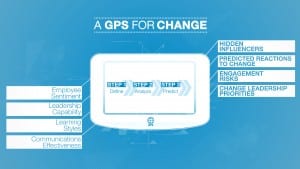 Change has changed: a cliché but it’s true. Organizations are operating more fluidly using informal networks. This new behavior coupled with today’s pace and complexity of change means that companies need a data-driven approach to leading change. To understand this let’s take a look at how change management has evolved.
Change has changed: a cliché but it’s true. Organizations are operating more fluidly using informal networks. This new behavior coupled with today’s pace and complexity of change means that companies need a data-driven approach to leading change. To understand this let’s take a look at how change management has evolved.
The Past: Leading Change Like Reading a Compass
Prior to the emergence of change theory in the late 20th Century there was little in the way of best practice. Leaders only knew the broad destination they were headed as most change was implementing tangible technologies and processes. It was like reading a compass: know the direction of travel and use your judgement and instinct to get there.
The Recent: Creating a Map for Change
Change theorists in the 1980s and 1990s suggested a series of approaches that represented an evolutionary step to codify what really works during times of change. This provided best practice techniques based on past evidence of success stories. It helped organizational development specialists create plans, in the same way a map provides the travel routes available from one place to another. This is the period of time when we began to understand that change is often over-managed and under-led, with too much focus on the map and not the destination.
The Now: Building a Change GPS
Today’s organizations challenge these approaches to change. Mainly because what these theories are based on is not immediately evident e.g. who are the real influencers, what are the barriers to change, and that there is often more than one path to success. The complexity of organizations, and the fact that change is now more continuous and volatile, makes planning around these insights exponentially more difficult.
What we need is a GPS for change: an active data-driven approach to predicting obstacles; identifying the best routes to take; and providing ongoing measurement and iteration. Let’s look at a typical change situation to bring this metaphor to life.
Implementing a New Organizational Strategy
New organizational strategies, and growing customer needs and expectations, often require new operating models and organizational capabilities. This places a large degree of change on the current workforce, some of whom may not fit the future state. Traditional change and workforce planning techniques have done a satisfactory job in ensuring business continuity. However, they have not consistently created an engaged and motivated workforce empowered to perform in the future state. This has an adverse impact on employee productivity and, ultimately, business performance.
How a Change GPS Can Help
The insight to prepare the workforce for the future state, and engage and enable them through the change, lies in data most organizations currently have or can easily collect. For example:
- Employee sentiment towards the organizational culture
- Leadership capability and style
- Employee learning styles and motivations
- Communications effectiveness
Much of this data already exists but it is seldom analyzed for change purposes. By collecting and analyzing this data before and throughout change we can create predictive models that identify many insights and trends. These include identifying:
- Hidden influencers who can act as champions of the new strategy, using organizational network mapping
- Predicted reactions to change, using typologies analytics, that will inform how to manage different employee groups
- Engagement risks, so proactive action can be taken to sustain the engagement of critical employees
- Change leadership development priorities aligned to the specific roles of leaders during change
- The actions, from recruitment to learning, that will make sure employees are fully productive in the future state
- Change adoption risks, identifying barriers to new ways of working and how to overcome them
This approach does not require perfect data, integrated databases, or shiny analytics systems. The “art in the science” is to take practical steps and make decisions on reasonable data that can provide a good degree of confidence. Over time these practical steps can be developed into a systemized ‘change GPS’.
So, how are you using the data you have on your colleagues to be more effective in a liquid change environment?